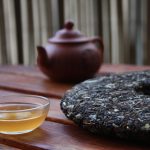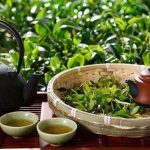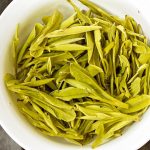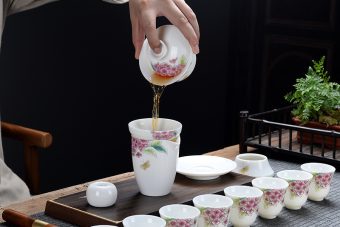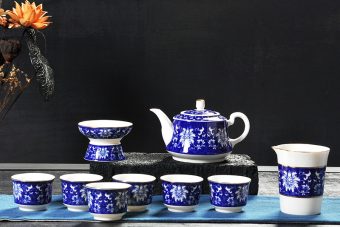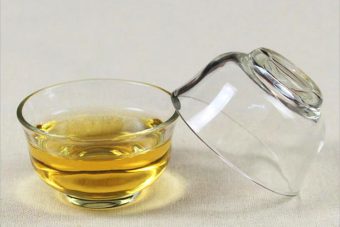The process of black tea production involves an intriguing chemical reaction, predominantly the enzymatic oxidation…

by vinux
- November 21, 2023
- 714
- 0
I. The Origin of the Tea Set
A. First Tea Sets in Han Dynasty, China (206-220 BC)
Marking the origins of the tea set takes us back to the Han Dynasty (206-220 BC) in ancient China. It was during this era that the first tea sets were introduced, reflecting the initiation of the tea-drinking culture. Tea was initially consumed for medicinal properties until these sets laid the foundation for the brewing process, thereby transforming the intake of tea into a leisurely activity.
B. Evolution of Chinese teaware (Tea sets) over centuries
The journey of the tea set in China spans centuries, with the design and material evolving considerably over time. Originally, they were made of crude earthenware and gradually sophisticated to the use of porcelain. Driven by the prolonged historical and cultural associations with tea-drinking, Chinese teaware played a vital role in the civilization’s art, philosophy, and even religion. With time, these changes are reflected within teaware designs, techniques, and choice of material, displaying a unique embodiment of Chinese aesthetic values and traditions in every sip of tea.
II. Introduction of Teacups and Saucers
While the history of tea itself and the art of tea drinking spans thousands of years, the introduction of the tea set components we are quite familiar with today, such as teacups and saucers, has a more recent origin.
A. Origin of the Teacup and Saucer in the Ming Dynasty (1368-1644)
The teacup and saucer as we know it today originated during the reigning period of the Ming Dynasty in China, from 1368-1644. This era marked a significant cultural shift from the use of simple tea bowls to the innovative implementation of handle-less tea cups, paired with small dishes or saucers. The saucer provided a convenient way to hold the hot cup without burning one’s hand, showcasing the intentional design driven by practicality and consideration for the user experience.
B. Role of Porcelain in the Innovation of the Tea Set
Porcelain played a substantial part in this innovation during the Ming dynasty. This premium, fine-grained white ceramic material had the aesthetic appeal combined with practical functionality. It was capable of holding hot liquids without cracking or breaking, could be shaped into delicate yet robust forms, and offered an ideal surface for detailed art and calligraphy – an aspect very much appreciated in the Chinese culture.
Pottery made of porcelain soon gained popularity for making tea sets, not only because of its superb practical properties, but also for the way that it allowed for excellent aromas and flavors of the tea to come through. Porcelain’s non-porous surface didn’t absorb the tea’s flavour, thus ensuring that each cup of tea tasted purely as it should. The birth of porcelain tea sets can therefore be said to have contributed immensely to enhancing the overall experience of tea drinking, elevating it from a mere routine act to an art form.
III. Porcelain: The Preferred Material
A. Brief on the first use of porcelain for utensils
The artistic beauty and practical utility of porcelain were swiftly recognized after its development. Flourishing first in the East, its fame reached the West, marking the beginning of an ever-growing demand. The first utensils crafted from porcelain date back centuries. The appeal was immediate, with people appreciating both its aesthetic and functional qualities. Porcelain’s resistance to high temperatures and its non-porous surface made it a favored material for utilitarian purposes, but its true charm lay in its opalescent luminance and delicate resilience.
B. Why porcelain became a popular choice for tea sets.
Porcelain catapulted to popularity for constructing tea sets due to a variety of reasons. The material’s non-porous nature made it ideal for holding liquids suchlike tea as it kept the flavor pure and unaffected by metallic or earthen tastes that other utensils might introduce. Porcelain could also endure high temperatures and resist staining—an essential factor considering tea’s natural staining properties. More than this, the sheer beauty, the tranquil purity and sheen of porcelain, made it a favored material for this ceremonial beverage, adding an air of refined elegance to the ritualistic culture of tea consumption.
C. Distinguishing factors between china, porcelain, and dinnerware
Terminology around china, porcelain, and dinnerware can often be confusing. ‘Porcelain’ and ‘china’ are frequently used interchangeably, as traditionally, china refers to the specific type of porcelain produced in the region of China. However, porcelain is a type of ceramic that is characterized by its translucent quality when held to the light. This unique attribute is due to the high temperature at which porcelain is fired and its refined, compact composition.
On the other hand, ‘dinnerware’ is a broad term that encompasses a variety of materials, including bone china, earthenware, stoneware, and yes, porcelain. So while porcelain and china could be categorized as dinnerware, not all dinnerware can be classified as porcelain or china. The primary distinguishing factors between them lie in the materials used, the temperatures at which they’re fired, and the resulting features such as strength, durability, and translucency.
IV. The Tea Set in the Western World
A. Influence of Eastern tea tradition on the Western world
The Eastern tea tradition, especially that of China, has undeniably played a crucial role in moulding the course of tea consumption in the Western World. The concept of tea drinking was introduced to the West in the 17th century by Portuguese and Dutch traders. This exotic beverage, neatly delivered in ornate tea sets, captured the fascination of a novelty-hungry Europe and began to engrain itself into their sociocultural fabric. It symbolized not only charm and elegance but also extended a taste of the exotic oriental culture.
However, these weren’t just about a fancy drink; the aesthetics of the elaborate Eastern tea sets equally mesmerized the Europeans. The blend of intricate Chinese designs and expert crafting on these tea sets portrayed a sense of foreign sophistication and elite class, thereby increasing their demand.
B. Adaptation and transformation of the tea set design in Europe
As the influence of tea drinking expanded across Europe, so did the requirement for tea sets. The growing obsession coupled with the scarcity of Chinese porcelain led to a transformation in tea set designs. It was during this period that Europe started creating its own version of the tea set, a blend of oriental stylings with Western practicality and aesthetic sensibilities.
Potteries across Europe, especially in England and France, started replicating Chinese porcelain. They began experimenting on local clays and glazes to forge a similar but distinctive style. It was no more just about sipping a hot beverage. These tea sets had to echo the values, traditions, and artistic prowess of Europe, thereby cementing the drink, and the elaborate paraphernalia surrounding it, deep into the Western culture.
From romantic rococo designs to elegant Victorian styles, the European tea sets bore the hallmarks of their respective eras, transforming from a commodity to a declaration of taste and status. In fact, the adaptation was so profound that this led to the birth of renowned porcelain houses like Meissen and Wedgwood, and gradually, porcelain became synonymous with European art and culture.
Thus, while the tea set may have originated in China, its journey through time and space has seen it adapt and transform, each rendition a reflection of its geographical and temporal context, culminating in the elaborate yet functional designs we see in today’s Western World.
V. Evolution of Tea Set Designs
A. Changes in Tea Set Design Over Time
Tea set designs have, predictably, evolved significantly over time. Their shapes, sizes, and detailing have reflected the progression of societal and cultural aesthetics. The first tea sets from the Han Dynasty in China (206-220 BC) were rather simple and utilitarian. Over time, they became more intricate, reflecting the evolving tastes and preferences. Innovations in materials, like the shift from stoneware in the Han Dynasty to refined porcelain by the Ming Dynasty (1368-1644), brought about significant changes in design, composition, and artistry.
B. Effects of Societal Changes, Occasion, and Tea Drinking Customs on Tea Set Design
Societal changes, occasions, and tea drinking customs have significantly influenced tea set design throughout history. The design of a tea set isn’t merely a matter of aesthetic taste or functional necessity. It’s also a reflection of the society from which it originates, an expression of customs and values. For example, the simplicity of early set designs mirrored a society where functionality was held in highest regard.
However, as tea ceremonies became more ritualistic and ceremonial in nature, tea sets began to reflect these socio-cultural shifts. The designs became more ornamental, infused with motifs and symbols that were representative of the culture and the stories of the people. For instance, during the Ming Dynasty, the introduction of tea and porcelain led to tea sets becoming symbols of social status, reflecting wealth and refinement. In the western world, influenced by their eastern counterparts, tea sets adopted the function of displaying high social standing.
Today, tea set design still plays a strong role in cultural and societal representation, seeing a resurgence of minimalist and individualistic designs that reflect our modern society.
VI. Modern Tea Sets
A. Contemporary versions and adaptations of the historic tea set design
In the ever-evolving spectrum of design and craftsmanship, modern-day tea set designs have undergone significant adaptations and transformations. Notably, the elemental essence of age-old heritage blends seamlessly with the trendy aesthetics of the current day, thereby giving birth to contemporary renditions. While the charm of antiquity still lingers, these updated versions cater better to the needs and tastes of the modern tea connoisseur. Designs now span from minimalistic monochrome sets, linking back to the stark elegance of the Han Dynasty sets, to extravagant hand-painted masterpieces reminiscent of the Ming Dynasty’s grandeur. Modern tea sets also incorporate innovative features like built-in infusers and heat-insulated handles, reflecting society’s advances in technology and convenience.
B. The role of porcelain in today’s tea sets
Porcelain, with its roots entrenched deeply in the history of tea sets, continues to maintain a dominant presence in modern times. It remains a popular choice due to its superior aesthetic appeal, durability, and its heat retention capability— a quality that is essential in preserving the warmth and flavor of the tea. Porcelain’s lightweight attributes and easy moldability also contribute to its continued usability, allowing designers to experiment with sophisticated shapes and styles. The fact that porcelain has not been overshadowed by other materials in our technologically driven world speaks volumes about its enduring supremacy. Furthermore, the role of porcelain in shaping the tea-drinking culture extends beyond East Asia and spans globally, reaching the Western world, making porcelain tea sets more than just dining ware – they are symbols of a unifying, centuries-old tradition.

